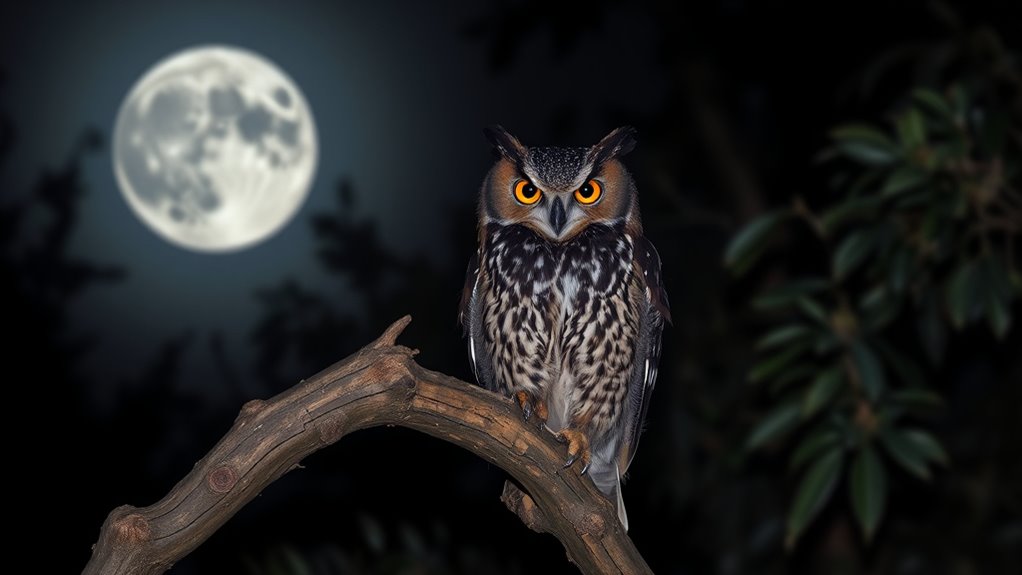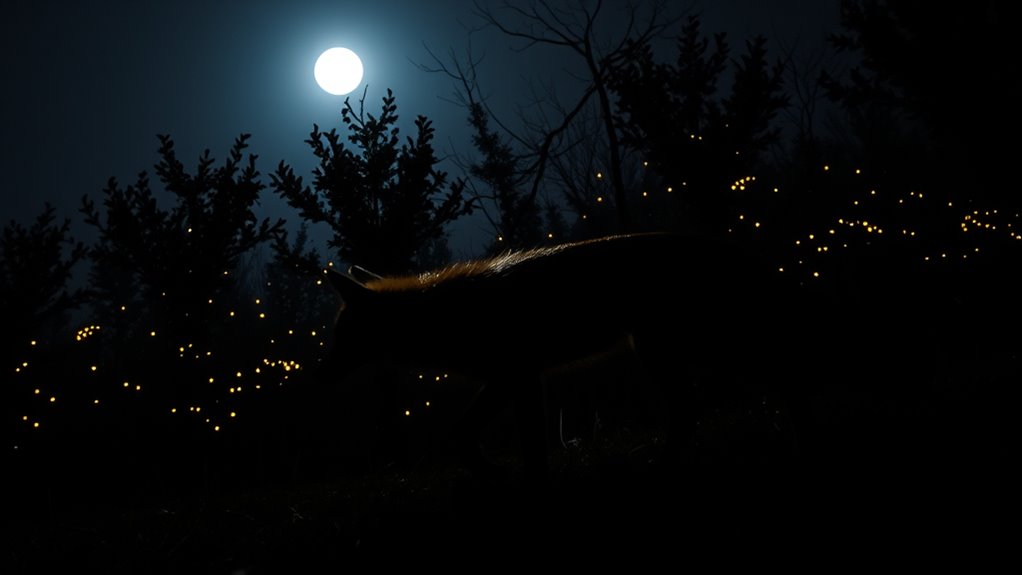Some animals are nocturnal because they've developed special adaptations to thrive in the dark. Their large eyes and sensitive retinas let them capture light effectively. Enhanced hearing abilities help them detect sounds, while keen senses of smell and touch aid in navigation and foraging. Nocturnal behavior keeps them safe from predators and reduces competition for resources. It also allows better temperature regulation during hot days. You might be curious about how these traits affect their survival—there's more to explore.
Key Takeaways
- Nocturnal animals have adaptations like large eyes and reflective retinas that enhance their vision in low light conditions.
- They possess acute hearing and specialized ear structures for pinpointing sounds, aiding in hunting and predator avoidance.
- A strong sense of smell allows nocturnal creatures to locate food from long distances, even in darkness.
- Nighttime activity reduces competition for resources, as fewer animals are awake during these hours.
- Nocturnal behavior provides a natural camouflage against daytime predators, enhancing survival rates.
Adaptations for Vision

Nocturnal animals have evolved remarkable adaptations for vision that allow them to thrive in low-light environments.
You'll notice they often have large eyes and wider pupils, helping them capture more light. Their retinas are packed with rod cells, making them incredibly sensitive to dim conditions. Many possess a reflective layer called the tapetum lucidum, which bounces light back onto their retinas for even better visibility. With increased photon capture from larger pupils and short focal lengths, they can see in darkness like no other.
While their color vision may be limited, their visual systems are finely tuned to detect movement and enhance contrast, allowing them to navigate their nocturnal world with ease. Additionally, their reflective layer aids in amplifying the available light, further enhancing their ability to see in the dark.
Hearing Enhancements

Many animals have developed impressive hearing enhancements that allow them to thrive in the darkness of night. For instance, owls have asymmetrical ears, enabling them to pinpoint sounds with remarkable accuracy. Cupped ears, like those of the Channel Island fox, help focus sound waves, enhancing localization. These adaptations not only aid in hunting but also in avoiding predators. Nocturnal animals often rely on their acute hearing to navigate and detect prey in low-light conditions.
| Hearing Mechanism | Function |
|---|---|
| Cupped Ears | Concentrate sound waves for better focus |
| Asymmetrical Ears | Improve sound source localization |
| Facial Discs | Funnel sound to ears for detection |
| Echolocation | Navigate and hunt using sound echoes |
These enhancements provide a vital survival advantage in their nighttime environments.
Use of Other Senses

While the darkness of night presents challenges, various animals have evolved to utilize their other senses effectively. Many rely on a keen sense of smell, like foxes and raccoons, which can locate food over long distances. They use scent marking for communication, ensuring social interactions thrive without visual cues.
Touch is another essential sense; whiskers help mice and moles navigate dark environments, detecting obstacles and food. Hedgehogs also rely on touch, moving confidently despite poor eyesight. Additionally, a developed sense of taste assists nocturnal foragers in identifying edible items in the dark. These adaptations—smell, touch, and taste—work together, allowing nocturnal animals to thrive in their unique habitats. Furthermore, their acute hearing plays a critical role in hunting and avoiding predators in the darkness.
Predator Avoidance

To escape the dangers posed by daytime predators, various animals have adapted to thrive under the cover of night. By being nocturnal, they reduce their chances of being spotted, as darkness provides natural camouflage. Many of these animals adjust their activity patterns to avoid peak predator times and select habitats with dense cover for added protection. While some nocturnal creatures may struggle to detect predators due to limited sensory cues, they often develop speed and agility to evade threats. Additionally, group living can enhance vigilance, allowing individuals to alert one another to danger. Overall, these adaptations are driven by the critical need to survive in environments where predation pressure is high, ensuring their ongoing existence.
Environmental Advantages

Nocturnal animals don't just avoid predators; they also gain significant environmental advantages by being active at night. These adaptations allow them to thrive in various conditions, enhancing their survival.
Here are three key benefits:
- Temperature Regulation: By being active at night, they avoid extreme heat, reducing dehydration risks in hot climates. This behavior is especially beneficial in regions where cooler nighttime temperatures help prevent heat stress.
- Reduced Competition: With fewer animals awake, they face less competition for food and water, increasing their foraging success.
- Optimal Humidity: Nighttime activity helps maintain essential humidity levels, vital for skin and respiratory health.
These advantages not only support individual survival but also contribute to ecosystem balance, highlighting the importance of natural nighttime conditions for these creatures.
Frequently Asked Questions
What Types of Animals Are Typically Nocturnal?
You'll find a variety of animals active at night, including mammals like aardvarks, bats, and raccoons, who thrive in darkness.
Birds such as owls and nightjars hunt efficiently under the cover of night.
Insects like crickets and moths emerge when the sun goes down, while certain reptiles and fish, including pythons and catfish, also prefer nocturnal activities.
This diverse group adapts to nighttime life for feeding, mating, and survival.
How Do Nocturnal Animals Find Mates at Night?
Ever wondered how creatures of the night find their perfect match? Nocturnal animals rely on a mix of visual signals, like bioluminescence, and auditory signals, such as songs or calls, to attract mates.
They often move silently, enhancing their stealth during courtship rituals. With specialized senses like keen hearing and smell, they navigate the darkness to connect.
Plus, pheromones play a big role in signaling readiness, making nighttime romance a fascinating dance of survival.
Are There Any Disadvantages to Being Nocturnal?
Yes, there are disadvantages to being nocturnal.
You may struggle with reduced foraging efficiency due to limited visibility, making it harder to find food. Increased vulnerability to predators can be a constant threat, especially if they adapt to your nighttime habits.
Additionally, light pollution can disrupt your reproductive cycles, and competition for resources can be fierce when multiple species are active at night.
Adapting to nocturnal life can also pose significant challenges.
How Does Urbanization Affect Nocturnal Animals?
Urbanization markedly impacts nocturnal animals by disrupting their natural behaviors.
You'll notice that artificial lighting alters their activity patterns, making them more active at night but also increasing their predation risk.
Noise pollution can lead to chronic stress, affecting their health and reproduction.
Additionally, habitat fragmentation reduces their access to food and shelter, further threatening their survival.
As urban areas expand, it's essential to reflect on how these changes endanger nocturnal wildlife.
Can Nocturnal Animals Adapt to Diurnal Lifestyles?
Did you know that around 30% of mammal species are nocturnal?
If you're wondering whether nocturnal animals can adapt to diurnal lifestyles, it's a complex challenge. They'd need to shift their circadian rhythms and adjust their sensory capabilities, like vision and hearing, to thrive in daylight.
Social behaviors and hunting strategies would also require significant changes. While adaptation is possible, it often takes generations and can affect their survival in new environments.
Conclusion
To sum up, the fascinating world of nocturnal animals reveals how they've adapted to thrive in the dark. You might wonder why some creatures choose nighttime over daylight, but think about how much quieter and safer it can be under a starry sky. These adaptations not only enhance their survival but also offer a unique glimpse into nature's ingenuity. So next time you hear a rustle in the night, remember, it might just be an amazing nocturnal friend!










